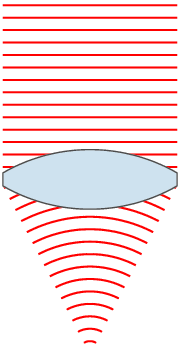Wavefront
Wavefront refers to an imaginary surface over which an optical, sound, or electromagnetic wave's phase is constant and in unison. In the context of optics and physics, a wavefront is often described as the surface of constant phase that represents the propagation of light or other waves. Understanding wavefronts is crucial in various fields such as astronomy, optometry, and in the development of technologies like Wavefront sensors and adaptive optics.
Definition[edit | edit source]
A wavefront can be conceptualized as the continuous locus of all points having the same phase of oscillation across a wave that propagates through a medium. In a three-dimensional perspective, these wavefronts can be spherical, planar, or of more complex shapes depending on the source of the wave and the medium through which it propagates. For instance, light emanating from a distant star would approximate a planar wavefront by the time it reaches Earth, whereas light from a point source close by would have a spherical wavefront.
Types of Wavefronts[edit | edit source]
Wavefronts can be classified based on their geometry:
- Planar Wavefronts: These are flat and extend infinitely in two dimensions, typically observed when the wave source is very far from the observer.
- Spherical Wavefronts: Originating from a point source, these wavefronts propagate outward in all directions in the shape of expanding spheres.
- Cylindrical Wavefronts: These wavefronts are generated by a linear source, expanding as cylinders around the source.
Wavefront in Optics[edit | edit source]
In optics, the concept of wavefront is pivotal in understanding how light interacts with lenses, mirrors, and other optical devices. Wavefront aberrations, deviations from the ideal wavefront shape, are critical in diagnosing and correcting optical imperfections. Technologies such as wavefront sensors and adaptive optics have been developed to measure and correct these aberrations, significantly improving the quality of optical systems in telescopes, microscopes, and the human eye.
Applications[edit | edit source]
- Astronomy: Adaptive optics systems use wavefront correction to compensate for the distortion of starlight caused by the Earth's atmosphere, enabling clearer images of celestial bodies.
- Optometry: Wavefront technology has revolutionized the field of vision correction, allowing for the diagnosis and treatment of aberrations in the human eye that were previously undetectable with standard methods.
- Laser Physics: In laser systems, controlling the wavefront of the emitted light is crucial for focusing power and achieving high precision in applications like cutting, welding, and medical surgery.
Wavefront Sensors[edit | edit source]
A wavefront sensor is a device that measures the phase shifts of a wavefront to determine its aberrations. The most common type used in optical applications is the Shack-Hartmann wavefront sensor, which divides the incoming wavefront into smaller segments and measures their deviations from the ideal wavefront.
Conclusion[edit | edit source]
The study and manipulation of wavefronts are fundamental to advancing optical science and technology. By understanding and correcting wavefront aberrations, scientists and engineers can enhance the performance of optical systems, leading to breakthroughs in various fields such as astronomy, optometry, and laser technology.
Search WikiMD
Ad.Tired of being Overweight? Try W8MD's physician weight loss program.
Semaglutide (Ozempic / Wegovy and Tirzepatide (Mounjaro / Zepbound) available.
Advertise on WikiMD
|
WikiMD's Wellness Encyclopedia |
| Let Food Be Thy Medicine Medicine Thy Food - Hippocrates |
Translate this page: - East Asian
中文,
日本,
한국어,
South Asian
हिन्दी,
தமிழ்,
తెలుగు,
Urdu,
ಕನ್ನಡ,
Southeast Asian
Indonesian,
Vietnamese,
Thai,
မြန်မာဘာသာ,
বাংলা
European
español,
Deutsch,
français,
Greek,
português do Brasil,
polski,
română,
русский,
Nederlands,
norsk,
svenska,
suomi,
Italian
Middle Eastern & African
عربى,
Turkish,
Persian,
Hebrew,
Afrikaans,
isiZulu,
Kiswahili,
Other
Bulgarian,
Hungarian,
Czech,
Swedish,
മലയാളം,
मराठी,
ਪੰਜਾਬੀ,
ગુજરાતી,
Portuguese,
Ukrainian
Medical Disclaimer: WikiMD is not a substitute for professional medical advice. The information on WikiMD is provided as an information resource only, may be incorrect, outdated or misleading, and is not to be used or relied on for any diagnostic or treatment purposes. Please consult your health care provider before making any healthcare decisions or for guidance about a specific medical condition. WikiMD expressly disclaims responsibility, and shall have no liability, for any damages, loss, injury, or liability whatsoever suffered as a result of your reliance on the information contained in this site. By visiting this site you agree to the foregoing terms and conditions, which may from time to time be changed or supplemented by WikiMD. If you do not agree to the foregoing terms and conditions, you should not enter or use this site. See full disclaimer.
Credits:Most images are courtesy of Wikimedia commons, and templates Wikipedia, licensed under CC BY SA or similar.
Contributors: Prab R. Tumpati, MD


